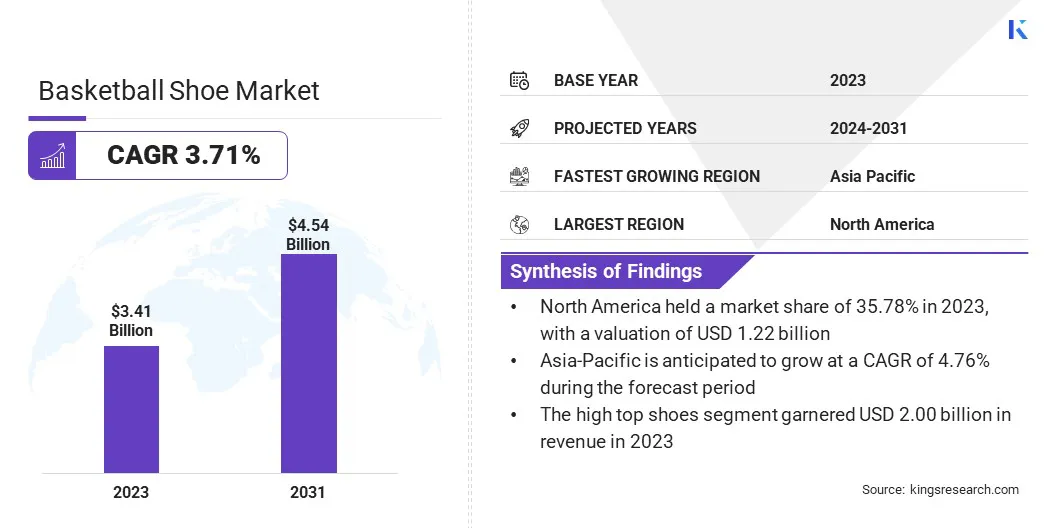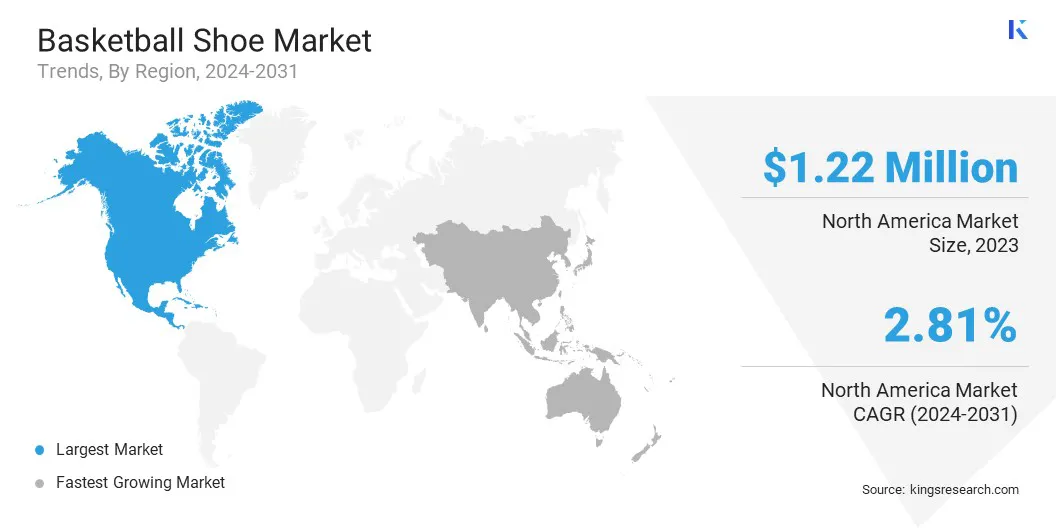Basketball Shoe Market Size
Global Basketball Shoe Market size was valued at USD 3.41 billion in 2023 and is projected to reach USD 4.54 billion by 2031, growing at a CAGR of 3.71% from 2024 to 2031. North America market was valued at USD 1.22 billion in 2023. The market is expanding due to a growing interest in the sport.
Major manufacturers such as Nike, Adidas, and Under Armour lead the market and employ strategic initiatives, including collaborating with professional athletes, to develop and introduce new shoe series while also promoting their products. Manufacturers are focused on developing new products that integrate the latest technologies, resulting in personalized offerings by using sustainable materials with increased functionality.
Challenges, including fierce competition from competitors, the proliferation of counterfeit products, and fluctuations in sales due to economic downturns, are influencing the market. However, increased demand from developing economies and a dedicated consumer base in North America are supporting the expansion of the basketball shoe market.
The market is majorly impacted by the growing popularity of basketball as a sport. Moreover, marketing strategies implemented by major brands, such as athlete endorsements and collaborations, are influencing consumer preferences. Furthermore, technological advancements, including the development of lightweight materials and advanced cushioning systems, are driving the demand for new products.
Consumers are increasingly searching for sustainably customized options when selecting their apparel and footwear. With the rise in disposable income levels and purchasing power, the market is likely to experience rapid growth in the forecast years.

Analyst’s Review
The global basketball shoe market is witnessing steady growth, fueled by rising interest in basketball worldwide. Major players such as Nike, Puma, Adidas, and Under Armour, among others, are dominating the market, driven by collaborations with prominent athletes and other endorsement deals, including the development of innovative designs.
Technological advancements, customization options, and sustainability efforts are key factors contributing significantly to the growth of the market. However, the market exhibits promising growth potential with increasing demand from emerging economies and a strong consumer base in established markets.
Basketball Shoe Market Growth Factors
The fusion of streetwear and basketball shoe culture influences the market significantly. Brand collaborations with streetwear designers and influencers to create unique products catering to fashion-forward basketball enthusiasts demonstrate consumer demand. These collections often showcase bold designs, premium materials, and limited availability, targeting sneakerheads and fashion enthusiasts.
This collaboration between basketball shoe design and streetwear trends creates exclusive, sought-after products that appeal to a niche audience seeking both style and functionality in their footwear choices. These products additionally draw attention of other consumers, thereby impacting the basketball shoe market with their new launches.
Another factor influencing the market is the rising focus on athlete-driven performance innovation. Close collaborations with professional basketball players result in the development of shoes tailored to their specific needs and playing styles. These shoes feature advanced technologies, including personalized cushioning, traction patterns, and support systems, thereby enhancing on-court performance.
These products cater to serious athletes and enthusiasts prioritizing performance-enhancing features in their basketball footwear.
Basketball Shoe Market Trends
The re-introduction of retro and nostalgic designs is an ongoing trend in the basketball shoe market. Various brands are reintroducing classic models and creating new shoes inspired by popular designs from the past. This appeals to sneaker enthusiasts, collectors, and other basketball fans interested in vintage aesthetics. Collaborations with NBA legends or retro-themed collections often generate excitement and buzz, which bolsters sales backed by nostalgia-driven consumer engagement.
Collaborations between basketball shoe brands and influential figures outside the sport, such as musicians, artists, and fashion designers, have gained significant traction in the market. These collaborations result in unique and exclusive limited edition shoe releases that capture the attention of sneaker collectors and enthusiasts. Partnering with cultural icons enables brands to create hype and demand, thus bolstering sales and brand visibility.
Additionally, limited edition collaborations provide a platform for creative expression and storytelling, thereby adding value and appeal to basketball shoe collections.
Segmentation Analysis
The global market is segmented based on product type, closure type, consumer orientation, distribution channel, and geography.
By Product Type
Based on product type, the market is segmented into high top shoes, mid-top shoes, and low top shoes. The high top shoes segment led the basketball shoe market in 2023, reaching a valuation of USD 2.00 billion. This dominance in the global market is mainly attributable to their superior ankle support, stability, and performance benefits during intense gameplay.
Furthermore, high top shoes have a rich tradition in basketball culture, are associated with iconic players, and are viewed as stylish both on and off the court. Major brands heavily promote high-top designs, offering customization options and innovative technologies, which is further solidifying their dominance in the market.
By Closure Type
Based on closure type, the basketball shoe market is divided into lace-up, zipper, and hook & loop. The lace-up segment secured the largest revenue share of 55.85% in 2023 due to its secure fit, versatility, and preference among players. Lace-up shoes offer customizable fitting options, crucial for performance and comfort while providing adequate ankle support without compromising mobility.
Major brands continually innovate lace-up designs with advanced technologies for enhanced performance and durability. Additionally, lace-up shoes often feature stylish designs appealing to both athletes and sneaker enthusiasts, thereby supporting the growth of the segment.
Basketball Shoe Market Regional Analysis
Based on region, the global market is classified into North America, Europe, Asia-Pacific, MEA, and Latin America.

North America basketball shoe market share stood around 35.78% in 2023 in the global market, with a valuation of USD 1.22 billion. North America leads the global market for basketball shoes due to the strong cultural significance of the sport in the region, with the NBA's status as one of the most popular and influential basketball leagues globally.
This popularity is leading to a higher demand for basketball shoes among players and enthusiasts. Furthermore, North America has a large population of basketball players at various levels, from amateur to professional, which is contributing to consistent sales and market dominance.
Asia-Pacific is poised to witness significant growth over the forecast period at a CAGR of 4.76%. This notable expansion in the global basketball shoes market is mainly fueled by increasing interest in the sport, driven by the popularity of leagues such as the NBA.
The region's large and expanding population, coupled with investments from major athletic footwear brands and advancements in the e-commerce industry, are contributing to the growing demand. These factors collectively create a conducive environment for the regional market growth.
Competitive Landscape
The global basketball shoe market report will provide valuable insight with an emphasis on the fragmented nature of the industry. Prominent players are focusing on several key business strategies such as partnerships, mergers and acquisitions, product innovations, and joint ventures to expand their product portfolio and increase their market shares across different regions.
Strategic initiatives, including investments in R&D activities, the establishment of new manufacturing facilities, and supply chain optimization, could create new opportunities for market growth.
List of Key Companies in Basketball Shoe Market
- Adidas AG
- New Balance
- Nike
- ASICS
- Puma
- Sketchers
- Under Armour
- Diadora
- ANTA SPORTS
- Li-Ning Company
Key Industry Developments
- April 2024 (Launch): Converse launched a new basketball shoe named 'All-Star BB Shift CX.' This model integrates elements from the All Star BB Shift Series and includes designs inspired by the Converse Run 'N Slam and Converse Tar Max Mid. It is equipped with an expanded Air Zoom unit in the forefoot and CX comfort foam within the midsole. Additionally, the upper part of the shoe includes a synthetic, adjustable cable lacing system that provides strong ankle support and facilitates movement in all directions. The release is scheduled for August 2024 at Converse's official stores and selected retail partners.
- February 2023 (Launch): Adidas and James Harden introduced the Harden Vol. 7, the latest iteration of Harden's signature basketball shoes, featuring advanced design technologies such as a new caged Jet Boost midsole, Lightstrike materials, and a full-length propulsion plate to enhance stability, cushioning, and agility.
The global Basketball Shoe Market is segmented as:
By Product Type
- High top Shoes
- Mid-top Shoes
- Low top Shoes
By Closure Type
- Lace-Up
- Zipper
- Hook & Loop
By Consumer Orientation
By Distribution Channel
- Specialty Stores
- Department Stores
- Wholesalers/Distributors
- Online Retailers
By Region
- North America
- Europe
- France
- U.K.
- Spain
- Germany
- Italy
- Russia
- Rest of Europe
- Asia-Pacific
- China
- Japan
- India
- South Korea
- Rest of Asia-Pacific
- Middle East & Africa
- GCC
- North Africa
- South Africa
- Rest of Middle East & Africa
- Latin America
- Brazil
- Argentina
- Rest of Latin America


